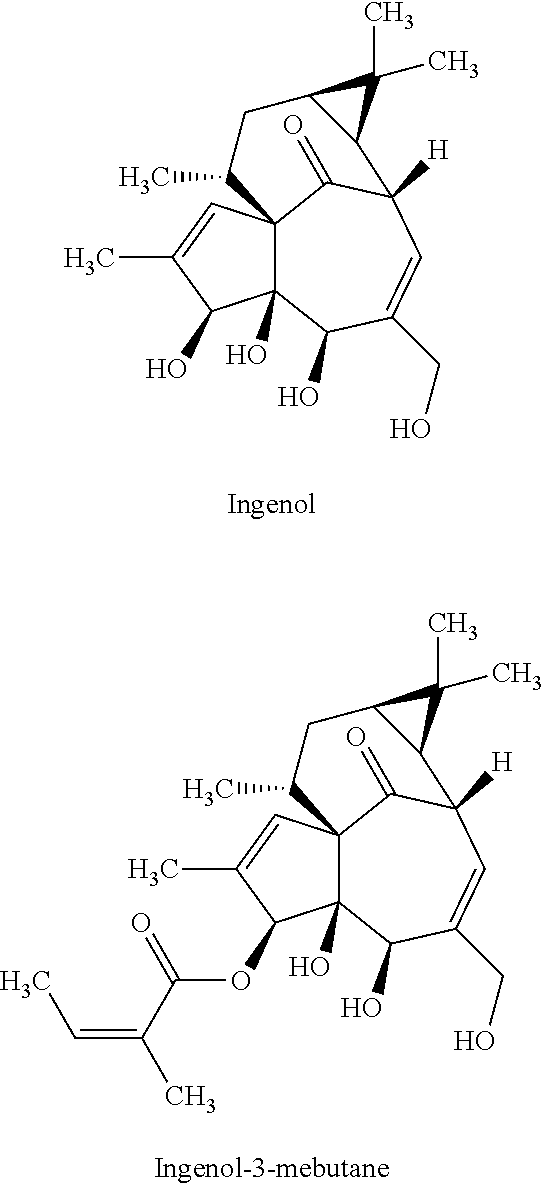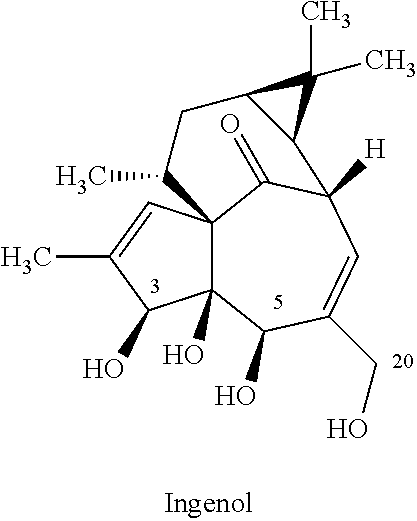A Continuous Flow Process For The Preparation Of Ingenol-3-Mebutate
a technology of ingenol and mebutate, which is applied in the preparation of organic compounds, carboxylic acid esters, organic chemistry, etc., can solve the problem of idleness of the vessel
- Summary
- Abstract
- Description
- Claims
- Application Information
AI Technical Summary
Benefits of technology
Problems solved by technology
Method used
Image
Examples
reference example 1
[0072]Initially, batch reactions were carried out for a one-step synthesis of ingenol-3-mebutate, starting from ingenol and using conditions similar to those disclosed in Scheme 1 (and reproduced herein below for convenience).
[0073]There are three reactive hydroxyl groups at C-3, C-5 and C-20 that can undergo angeloylation. Evidence for reaction at the C-4 tertiary hydroxyl group is not mentioned in literature, presumably due to the steric environment and therefore can be considered as being a much less reactive. Theoretically speaking, three reactive hydroxyl groups should give ˜33% of each isomer if all three hydroxyl groups were assumed to be identical. However, the hydroxyl groups at C-3 and C-5 of ingenol are secondary and the hydroxyl group at C-20 is primary. Given the structural geometry and complexity of ingenol, a difference in the reactivity of the three hydroxyl groups can be expected. Furthermore, primary hydroxyl groups are typically more reactive and the angeloylation...
reference example 2
[0077]Reactions to maximize ingenol-3-mebutate formation were pursued first by conducting a solvent screen. As shown in Table 3, 2-Me-THF (Me-THF) appeared to give a better selectivity towards the desired C-3 hydroxyl group relative to THF or toluene when using the method for Trial 2, Table 1. Solubility issues were observed with toluene initially but complete dissolution occurred with the addition of LiHMDS. Based on these experiments, 2-Me-THF was selected for further development.
TABLE 3Results of batch reaction for solvent screeningUPLC (% a / a) AnalysisTrialIngenolConditionsIngenC-5C-20C-3C-3,201104 mg1. Charged ingenol and3.820.109.945.3316.31*PhCH3, cooled to 10° C.2. LiHMDS (1.2 eq), 10° C., 2 min3. Anhydride (1.2 eq) inPhCH3, 10° C., 5 min4. Warmed to 25° C. (15 min)and quenched with1M HCl(aq)2 98 g1. Charged ingenol and Me—THF,7.670.279.8117.3929.55cooled to 10° C.2. LiHMDS (1.2 eq), 10° C., 2 min3. Anhydride (1.2 eq) in Me—THF,10° C., 5 min4. Warmed to 25° C. (15 min)and qu...
example 3
s Flow Reaction for Preparation of Ingenol-3-Mebutate
[0078]A three line microreactor cell was used with the lithiation of ingenol conducted externally. The parameters investigated for the angeloylation of ingenol using the continuous flow microreactor are displayed in Table 4. The study focused on the proof of concept by varying temperature and flow rates to maximize the selectivity, impurity formation, and conversion.
TABLE 4Investigation of a continuous flow reaction forpreparation of Ingenol-3-mebutateLineTempFlow (μL / min)Trial*ABC(° C.)ABC1LithiatedAngelic1M HCl222525302ingenolanhydride(aq)102525303in Me—THFin Me—THF025253040.25M0.25M−10252530522131315610131315701313158−101313159101315151010131815*Conducted using a Chemtrix, Labtrix model continuous flow reactor with microreactor cell #3223
[0079]Surprisingly, as illustrated in Table 5, the ingenol-3-mebutate was observed to be the major product in all trials. As well, the double angeloylation impurity (ingenol-3,20-mebutate) was ...
PUM
| Property | Measurement | Unit |
|---|---|---|
| flow rate | aaaaa | aaaaa |
| flow rate | aaaaa | aaaaa |
| concentration | aaaaa | aaaaa |
Abstract
Description
Claims
Application Information
 Login to View More
Login to View More - R&D
- Intellectual Property
- Life Sciences
- Materials
- Tech Scout
- Unparalleled Data Quality
- Higher Quality Content
- 60% Fewer Hallucinations
Browse by: Latest US Patents, China's latest patents, Technical Efficacy Thesaurus, Application Domain, Technology Topic, Popular Technical Reports.
© 2025 PatSnap. All rights reserved.Legal|Privacy policy|Modern Slavery Act Transparency Statement|Sitemap|About US| Contact US: help@patsnap.com



